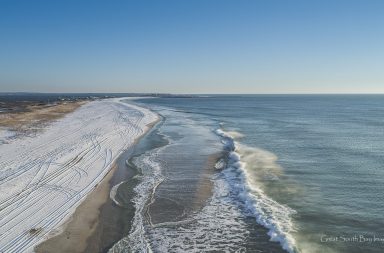By Mike Busch
Capturing the Milky Way on Long Island can be a challenge. Living within 100 miles of one of the biggest cities in the world has its advantages but the light pollution that New York City creates is a huge problem for star-gazers.
As you can see in the map below generated by NASA satellites, Long Island looks to be one of the worst spots in the U.S.A. for seeing stars at all, much less capturing a quality image.

Credit: NASA Earth Observatory/NOAA NGDC
However if you pick the right time of year and the right night (relatively low humidity and a late rising moon) you can get a decent view with the naked eye and a nice image with the right equipment.
The peak of the Milky Way season is considered to be around the June Solstice but it can be seen from March through October.
Regarding equipment, I would recommend a full frame camera with a wide-angle lens with a low aperture. A tripod is a must and be prepared to adjust your exposure and ISO settings to see what works.
The hardest thing to do is focus. Since you are using a wide-angle lens and won’t have anything bright enough to see in the view finder, you will need to manually focus to infinity and then adjust for the sweet spot. With many lenses that means spinning the focus ring slightly back from infinity, for some reason that may be your sharpest position.
Once you have a shot in focus and the exposure correct your work is not done. Most likely you will have a flat image in dire need of processing. I use Adobe Lightroom for my RAW images and in a matter of seconds I can bring up the detail of the stars using contrast, highlights, clarity and my new favorite slider for stars, dehaze. Below is a my favorite photo of the night right out of the camera, the rest of the images were all processed with Lightroom.
Last Wednesday night I was up late working on my website when I noticed how clear the sky was. Knowing the Milky Way has been visible I first hit the edge of the Bay in Brookhaven.
As soon as I got out of the car I knew it would be good, I could clearly see the Milky Way with the naked eye even before my eyes adjusted. I took a quick test shot from the road and then a few over Bay below with my 24-70 2.8 lens. Both shots were at F 2.8, 30 seconds, and ISO of 1000.

I had a bunch of light pollution here so the next move was to get a look over the ocean. Experience told me to head East where light pollution drops off dramatically but low clouds in that direction made my only choice Smith Point Beach.
Here I had to battle lights from both the Beach Hut and the Fire Island National Seashore visitor center but after a short walk west I found a nice spot with a tidal pool in front of the breaking surf. For these shots I changed lenses and went to my ultra wide Nikkor 14-24, way too much sky for my 24-70mm. Most of the setting were similar, between 20 and 30 second exposures at 2.8 with ISO between 500 and 1000.
More images on Page 2







